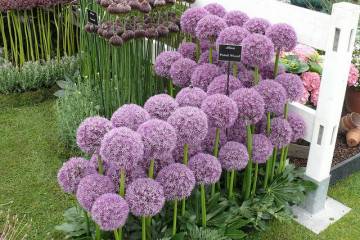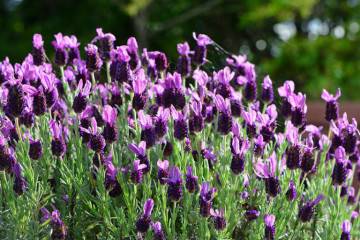Perennial garden tradescantia - planting and care in the open field
Content:
Tradescantia has many other names: American grass, woman's gossip. Despite the species diversity, breeders do not get tired of delighting with new hybrid varieties with large buds or bright greens. Tradescantia is loved by gardeners: they decorate plots with it, use the plant in landscape design.
What does it look like, which family it belongs to
A herbaceous perennial from the Kommelinov family grows up to 1 meter, dwarf species are low - up to 20 cm, often grown as indoor plants. The shrub has thin nodal shoots, a fibrous root system. Leaves are petiolate, spreading, from ovate with a pointed tip to elongated lanceolate. Flowers are small, 3-petaled, with white or colored buds. In winter, the plant does not freeze under a layer of mulch.
Briefly about the history of appearance
The flower received the name Tradescantia in the 17th century, when a gardener at the court of the English king Charles the First planted it in the garden. The gardener's name was John Tradescant, he was the first to take up plant breeding. Anderson's Tradescantia is named after another grower, a Danish botanist, who bred varieties with large, colored buds.
Homeland of the plant
The flower came to England from the American state of Virginia. Virginia is a group of narrow-leaved varieties.
Care features
Home culture care is not much different from gardening. The main thing is to follow the basic rules of agricultural technology.
Watering
For full growth, the earth is kept moist. The watering regime depends on the place of growth. Where there is abundant dew, the soil dries up only during dry periods. If there is no precipitation for a long time, Tradescantia is watered by sprinkling.
Spraying
The bush flower is a child of the humid subtropics. In addition to watering at home, the plant needs regular spraying. Once a month, it is useful for the bush to arrange a warm shower.
Priming
The soil should be nutritious, rich in humus. When planting at home, they choose land for melons and gourds or universal soil, additionally it is necessary to season it with microelements.
Top dressing
At each stage of growth, Tradescantia gratefully responds to feeding, becomes lush, abundantly releases inflorescences. Fertilization stage:
- the first feeding with nitrogen fertilizers is done at the beginning of the growing season. The plant needs to actively build up its green mass. Minerals are applied during spring weed harvesting, when loosening;
- the second - complex, is carried out after 2 weeks, when the formation of flower buds. You can use universal dressings for home flowers or a mixture of superphosphate, potassium nitrate and calcium sulfate.
Wintering
For the most cold-tolerant tradescantia varieties of Anderson, autumn pruning is not provided for in planting and care, the roots cover the shoots. The rest of the varieties are trimmed, leaving hemp up to 5 cm in height. The planting is covered with a 10 cm layer of mulch (rotted sawdust, peat or humus). Shrub tradescantia under such a shelter is not in danger of wintering.
When and how it blooms
Tradescantia in the garden surprises with a variety of colors, size and shape of buds.
Types of flowers
Inflorescences up to 4.5 cm in diameter, consisting of three pointed petals. In the center there are high fluffy orange stamens, sometimes reaching 10 mm. The buds are monochromatic, two-colored and with contrasting strokes. Simple and terry. The color depends on the variety, the petals come in different shades:
- pink;
- purple;
- purple;
- red;
- purple;
- white;
- dark blue;
- light blue.
Flower shapes
Cup-shaped when wide petals overlap. Some species are disc-shaped.
Flowering period
Garden Tradescantia pleases with flowers from 3 to 4 months. All summer buds are renewed on the plant.
Pruning
Tradescantia in the garden, in addition to growing and grooming, requires a "haircut". Pruning of growth points is carried out in the spring in the growth phase, so that the plants bush more strongly.
How does it multiply
Seed and vegetative propagation is acceptable.
Seed propagation
They are planted without preparation, in late autumn they are sealed to a depth of 1 cm. In the spring, seedlings dive.
Dividing rhizomes
Thickened plantings are dug up, plots are formed from the mother bush with scissors. In this way, rare species can be preserved.
By cuttings
Cuttings are selected in spring, germinated, rooted in a permanent place.
Transfer
Small pits are made, the root system is shortened by 1/3. After watering, the seedlings are mulched.
Possible growing problems
If you take proper care of the bush, it will develop immunity, it will be able to resist diseases itself.
Pests
Scabbards, spider mites are destroyed with acaricidal preparations, and aphids are fought with folk remedies: tobacco crumbs, soapy water.
Other problems
In a shaded area, narrow-leaved species do not bloom well. With a lack of moisture, the tips of the plates turn yellow and become brittle.
Views
The long-leaved Virginia Tradescantia is distinguished by different colors. Planting and caring for cultivated varieties does not take much time, the plant is resistant to diseases. Rubra and Atrorubra have red buds, Rosea has a deep pink color, Coerulea produces blue or blue buds.
The white, bowl-shaped variety is one of Anderson's Tradescantia varieties. It grows up to 60 cm, forms a dense bush.
In the white-flowered species (Tradescantia albiflora), the leaves are lanceolate, glossy with colored veins. The flowers are small, the variety is valued for its greenery. Aurea with yellow stripes on the leaves or completely yellow. Albovitata has white stripes; Laekensis has whites complemented by pinks.
Tricolor - with white and purple veins.
Sillamontana produces medium-sized pink buds, the leaves have a cobweb-like edge. Varieties of garden blue Tradescantia are distinguished by long flowering, retain their decorative appearance for up to 4 months. Low-growing variety - "Ruddy Bride", bushes up to 40 cm high, flowering continues from June to late August. In warm regions, a popular blue-bud mixture, which is cultivated as an annual crop, is sown in the ground in April, after the snow melts.

In the garden, they are planted in groups or together with other crops. They often serve as living supports
Neighborhood with other colors
Street Tradescantia decorates recreation areas, reservoirs. In sunny places, it is better to place species with colored greenery, lanceolate leaves. In the shade, narrow-leaved perennial varieties that delight with colored buds take root well.
Application in landscape design
The flower is suitable for decorating flower beds, vivariums. Colored tradescantia on a flower bed, an alpine hill will become a bright accent. Varieties with colored lush greenery are used in landscape design for border planting. Such tradescantia in the garden is appropriate along the park paths.
It is undesirable to transplant narrow-leaved abundantly flowering species on open parterre lawns; it is better for them to find a place where a shadow from trees or buildings appears at noon. The bushes will feel great.
Shrub tradescantia garden perennials are able to transform any landscape. This plant is in demand among gardeners because of its ease of care, ease of reproduction. Cold-resistant varieties can be found in temperate climates.


















